Japan's traditional musical instruments
Each country is distinguished by its musical instruments and Japan is no exception. Unusual and exciting traditional musical instruments of this faraway land of the rising sun for Europeans attract tourists from all over the world.
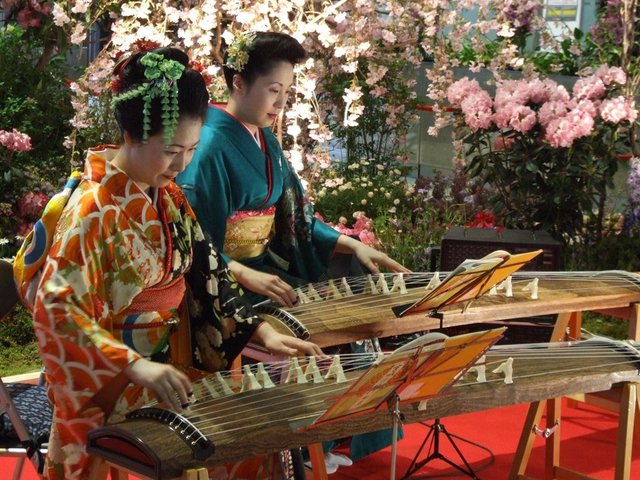
source
Here you can hear the ancient Buddhist chanting and court music of the Edo period, and various religious performance on ancient musical instruments that exist in Japanese culture for many centuries. Interesting history of the development of Japanese traditional music, which begins with the ancient Jomon and continues to this day.
In the course numerous archaeological excavations in Japan were discovered musical stone whistles, unique singing chalice, - called Rin, found even and singing wells. Such bowls was making beautiful melodic sounds, they are not hung and not attached, they just stood in a certain place.
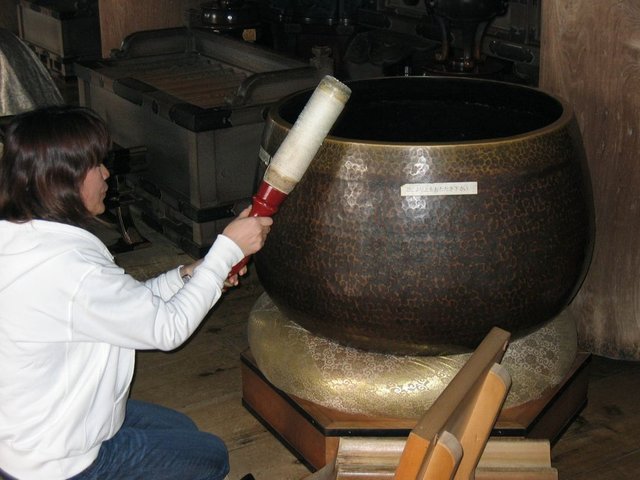
source
And the singing wells suikinkutsu was a huge inverted jars partially buried in the ground, over which were bamboo tubes with water flowing down drop by drop into a small hole in the bottom.
They will be able to play anyone who wants, and you do not need to have a special musical ear, everything will happen by itself, when you become a hand wash.
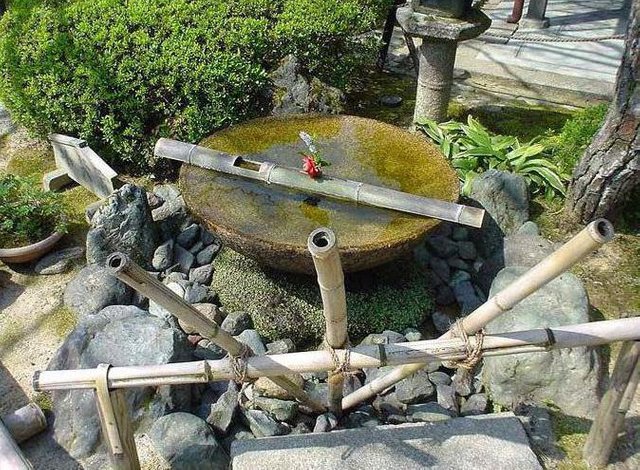
singing well
Japanese music is based not on a certain mathematical count, but on the intervals of human breathing. The Japanese are still mysterious magical rituals accompanied by music, which was a significant addition to any national ceremonies.
In ancient times in Japan Palace music were United under the name of gagaku. However, many of the old melodies lost, they could not be saved, as in Japan there was no system of musical records, musical works were passed down from generation to generation.
Until the Meiji era (when Japan began to penetrate the European model note records) only used a certain notation in the form of lines, all kinds of figures and characters that symbolized the strings are pointing to the correct tempo and determines the nature of a work.
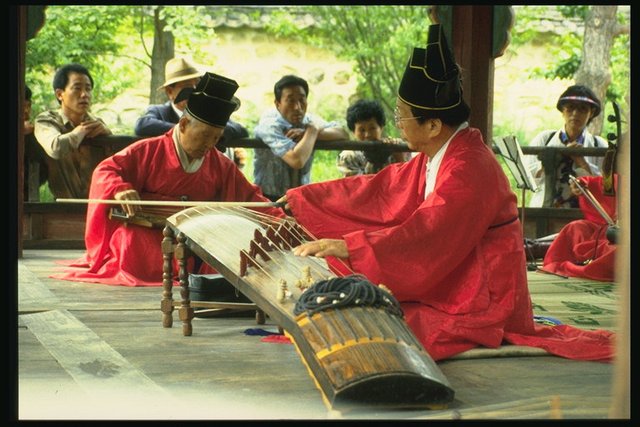
game on ancient instrumento
Musical performances often took place at temples, but the beginning of such performances put a Buddhist priest by the name Kenjun. He also came up with all sorts of songs for voice and Japanese musical instruments.
A very popular tool today is the koto, a plucked string instrument with a special elevations ("horses") through which the musicians can change the melody key. Koto was brought from China in the era of Nara, and first used only in Palace music.
Play koto very difficult, must be attached to the fingers of the special invoices "nails-picks" katazome, worn only 3 fingers of the right hand (thumb, index and middle). Lyrics for the songs were not subjects, they did not have and explicit plot, but they ended always in a certain motive.
Not less interesting musical instrument has become and Biwa. Under this word, the Japanese called a number of lute instruments, which were mentioned in written sources, since the VIII century. Its proliferation contributed to the formation of the song.
In the game of biva often alternated vocal number of the singer-narrator with musical accompaniment, and the sounds were extracted by means of a special long bone mediator (plectra).

Japanese Biwa
Nowadays, the most familiar traditional instrument, of course, is Xiamen, which appeared in the XV–XVI centuries. Samisen immediately liked the Japanese and even wandering musicians (Gaza) always took it with me to travel around the country.
Musicians with high skill, extract from them special magical sounds-savari. And shamisens differ from each other and height of tone, and various timbral coloring.
Syamisen are made from hardwood, but the body of the tool before tight fitting cat and dog skin. The strings are made of natural silk or nylon. Today, none of the Japanese theatre is not without samisen, the game at the moment even Maiko — future of the Japanese geisha.
Have the Japanese instrument that resembles an oboe, they call him heteric. It originated from the Chinese instrument Guan, which penetrated into Japanese culture in the VIII century. It is made of bamboo and are often adorned with bark cherry wood. Size it is small, only one octave, and resembles a flute. Yes, and the holes on the body are similar.
In the XVI century there have been significant changes in Japanese traditional music. There was a new instrument- * * syakuhati**, which initially played only the monks of the fuke school.
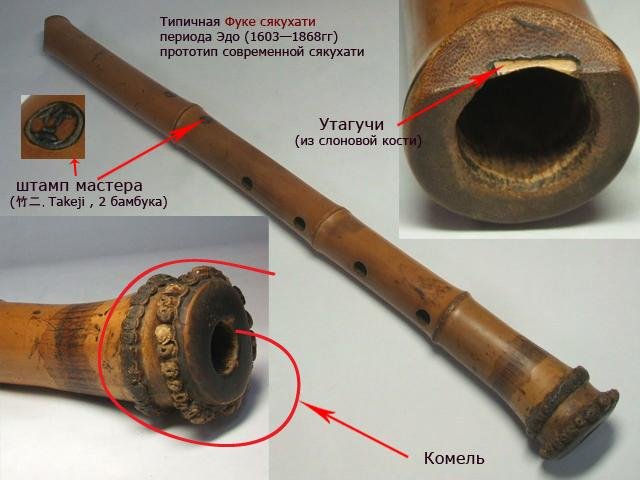
vintage shakuhachi
With the advent of this tool, an idea of the sacredness of the music performed on the flute arises. And the ancient legends attributed its miraculous power the name of Prince Shotoku Taishi (548-622). He was a statesman who often wrote and commented on Buddhist sutras.
In some written sources of the early middle ages it was said that when Prince Shotoku on the way to the temple, played on a shakuhachi, to the sounds of his melodious flute down even the heavenly fairies and dancing. Original Japanese flutes reach a length of about 55 cm And sound of these musical instruments at the performances.
In Japan, of course, there were drums and just here they are called — Taiko (which means a large drum). A beautiful name for a musical instrument, isn't it? However, this word meant only large drums used in the Shinto with the worship of the wind God susanoo. The body of such musical instruments was hollowed out of a solid piece of solid wood, but they were played with special sticks — Bati.
The Japanese drums were significant differences. Some of them can be adjusted, they had special cords and different screws, these are called Sime-daiko. But others be-daiko, had only the hard membrane, tightly secured with nails (in which it was impossible to change the sound).
The essence of Japanese music is multifaceted, it can not be expressed through any one instrument, it consists of many principles and directions. It has harmony and respect, extraordinary purity and simplicity, melodiousness and silence, mystery and originality. Japanese music should be able to listen, it will help you to relax and enjoy...
Ah, and in our days the Japanese like play and on taishakato. It's such autoalpha resembling a cross between a guitar and an accordion :-)
Music can do a lot. Discard the superfluous, unnecessary, disturbing, bulky. To highlight the paramount, and most importantly, to spiritualize, to bring us closer to nature, teaches us to see beauty in naturalness and to appreciate life.
Every country has some traditional musical instruments that you shared with us that we found some traditional Japanese musical instruments and got some chance to know some unknown information about music.
Thank you for your attention and interest ))